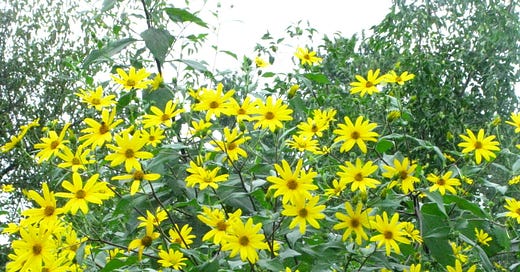The Jerusalem Artichoke is widely known in homesteading circles as an aggressive, native root consumed by indigenous people long before colonists arrived. Although the plant is thought to be one of the oldest cultivated crops in North America, there's a lack of physical evidence, such as fossilized tubers, to confirm its early cultivation.1
That said, we aren’t without extensive evidence of its use. The Cree and Huron peoples of eastern North America refer to the plant as “askipaw” and “skibwan,” meaning, roughly, “raw thing.” This suggests that historically, the tubers were consumed raw, a practice confirmed by later historical accounts. Sources lack specific details about the agricultural techniques used by Indigenous peoples to manage the landscape and cultivate Jerusalem artichokes, but we can assess a few things.
For example, based on the plants' genetic lineage, researchers suspect that they originated in the north-central region of the US near the Great Lakes.2 This is primarily because this is where the largest wild populations exist, although wild populations are far more common across the eastern half of the continent.3 Recent research assesses the natural distribution of possible progenitor species that might have hybridized to produce Jerusalem artichoke. When we look at maps of the regions of other Helianthus species, the Great Lakes offers the most common overlapped region.4 The evidence presented suggests a strong association but no confirmation of its origin.
Samuel de Champlain, a French explorer, first observed the Jerusalem artichoke in 1605 during his explorations of the North American coast. While he never uses the term “sunchoke” or “Jerusalem artichoke,” his journal entries describe encountering a plant and its tubers during his voyages. On July 21st, 1605, upon visiting the Eastern Abenaki people of Cape Cod, he describes, “We saw some roots which they cultivate, which have the taste of artichokes.”5 He noted that the roots were actively cultivated, not simply gathered from the wild, explaining that they saw “an abundance of Brazilian Beans, many edible Squashes of various sizes, Tobacco and roots which they cultivate, the latter having the taste of Artichokes.” He implies that the plants were grown in a polycrop in a diverse agricultural system employed by the Abenaki.
The following year, at Gloucester Harbor (which Champlain named Beauport), he describes the setting of the sunchoke again, stating:
It was a native settlement, comprising two hundred savages, who were cultivators of the soil, which was prolific in corn, beans, melons, pumpkins, tobacco, and grapes. The harbor was environed with fine forest trees, as hickory, oak, ash, cypress, and sassafras. Within the town there were several patches of cultivated land, which the Indians were gradually augmenting by felling the trees, burning the wood, and after a few years, aided by the natural process of decay, eradicating the stumps. The French were kindly received and entertained with generous hospitality. Grapes just gathered from the vines, and squashes of several varieties, the trailing bean still well known in New England, and the Jerusalem artichoke crisp from the unexhausted soil, were presented as offerings of welcome to their guests.
While Champlain’s descriptions are brief, they provide valuable historical insights into the early cultivation and management of the sunchoke by indigenous people in North America.
After its discovery, the sunchoke quickly gained popularity as a food source, particularly in France, and was widely cultivated. Sources suggest it was likely introduced to France around 1607, only a few years after colonists discovered it, and possibly by Marc Lescarbot, a lawyer who had traveled to the French settlement of Port-Royal in Acacia (present-day Nova Scotia, Canada), where it spread across western Europe.6 Lescarbot was in charge of the gardens at Port Royal, which may make him a more likely candidate for the introduction.
However, he doesn't mention bringing the tubers back to Europe in the first two editions of his book. It is only in the 1617 edition that he claims to have brought the tubers back. This may be because the species was initially of minor importance. Its growing popularity during the subsequent decade may have encouraged Lescarbot to provide a more comprehensive account.
Further complicating its origins in the Old World was the diversity of names applied to the plan. The most common name, "Jerusalem artichoke," is a double misnomer. The plant is neither related to artichokes (Cynara scolymus) nor does it have any connection to Jerusalem. The "artichoke" part of the name likely arose from early European explorers comparing the taste of the cooked tubers to that of globe artichoke hearts, as noted by Champlain. Similarly, the Scandinavian name "Jordskok" comes from the tubers being in the soil ("jord") and tasting like artichokes ("artiskokkens").7
Keep reading with a 7-day free trial
Subscribe to The Poor Prole's Almanac: Restoration Agroecology to keep reading this post and get 7 days of free access to the full post archives.






